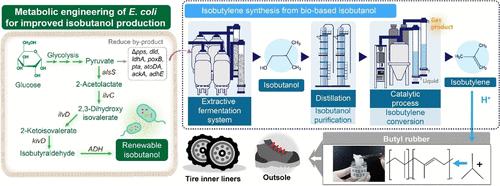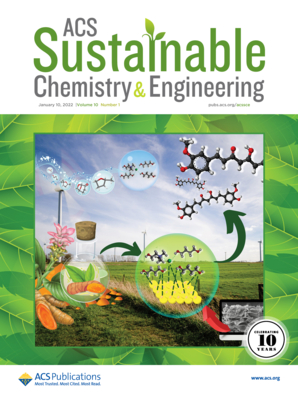Sustainable Butyl Rubber Production from Microbial Isobutanol-Derived Isobutylene
IF 7.1
1区 化学
Q1 CHEMISTRY, MULTIDISCIPLINARY
引用次数: 0
Abstract
Isobutylene, a monomer for butyl rubber production, is traditionally obtained via the thermal cracking of natural gas. However, this route should be superseded by those that rely on the chemical or biological valorization of renewables to reduce our dependence on fossil resources. Despite extensive research on biobased butyl rubber, its economically viable large-scale production from bioisobutylene remains underexplored. This study develops a process for the microbial production of isobutanol and its conversion to isobutylene and butyl rubber. The fermentation of glucose by metabolically engineered Escherichia coli afforded isobutanol, which was removed from the culturing medium via absorptive vapor capture using water in a recovery tower to prevent cytotoxicity-related problems, concentrated via batch distillation and selectively dehydrated to isobutylene over γ-Al2O3/HCl. The low-temperature cationic copolymerization of isobutylene with isoprene afforded butyl rubber with properties suitable for commercial applications. Computational modeling validated the efficiency of the absorption tower and underscored the need for a multistage distillation tower for optimal isobutylene recovery. This study presents a framework for sustainable chemical production and contributes to the development of ecofriendly and commercially viable technologies.

求助全文
约1分钟内获得全文
求助全文
来源期刊

ACS Sustainable Chemistry & Engineering
CHEMISTRY, MULTIDISCIPLINARY-ENGINEERING, CHEMICAL
CiteScore
13.80
自引率
4.80%
发文量
1470
审稿时长
1.7 months
期刊介绍:
ACS Sustainable Chemistry & Engineering is a prestigious weekly peer-reviewed scientific journal published by the American Chemical Society. Dedicated to advancing the principles of green chemistry and green engineering, it covers a wide array of research topics including green chemistry, green engineering, biomass, alternative energy, and life cycle assessment.
The journal welcomes submissions in various formats, including Letters, Articles, Features, and Perspectives (Reviews), that address the challenges of sustainability in the chemical enterprise and contribute to the advancement of sustainable practices. Join us in shaping the future of sustainable chemistry and engineering.
 求助内容:
求助内容: 应助结果提醒方式:
应助结果提醒方式:


